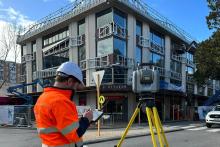

Global awareness of climate change has intensified. The construction sector is under increasing pressure to reduce its carbon footprint and adopt more sustainable practices. Approximately 40 percent of global carbon emissions are attributed to the construction industry according to the “Net-zero Buildings Halving Construction Emissions Today” report by Arup [1]. Around 11 percent of this total stems from the embodied carbon in building materials. This alarming statistic highlights the important need for change, whilst the economic benefits of moving towards carbon neutrality are becoming increasingly apparent.
The reasons for adopting sustainable construction differ, with the most significant being the need to combat climate change by reducing carbon emissions. The Arup report highlights the importance of immediate action, stating that halving construction emissions today could significantly contribute to achieving global net-zero targets by 2050. This transition requires a reimagining of how buildings are designed, constructed and even deconstructed – with a focus on minimising the carbon impact at every stage of the building's life cycle.
Achieving sustainable construction comes with numerous challenges. Initial investment in greener technologies and materials can be significant, and there is often a knowledge gap in the industry regarding best practices for reducing embodied carbon. Fortunately, these obstacles are gradually being overcome as more stakeholders recognise the long-term financial benefits, which include lower power costs from energy-efficient building features and increased property value. Government incentives, stricter building codes and growing consumer demand for greener buildings are all accelerating the adoption of sustainable practices.
In the pursuit of sustainability within the construction industry, Arup identified the concept of "building nothing" as the most impactful strategy for reducing carbon emissions. This approach, which advocates for avoiding new construction altogether, directly addresses the issue of embodied carbon. These emissions are generated from the production and transportation of building materials, as well as the construction process itself. By not building, the carbon footprint associated with new projects is eliminated, making it the most environmentally beneficial option.
However, in a world where development and urbanisation are ongoing realities, "building nothing" is not always a feasible solution. This is where the repurposing and refurbishing of our existing built environment emerges as a strong alternative. Arup's report highlights this approach as the second most effective strategy for sustainability in the construction sector. The process of repurposing and refurbishing existing buildings allows us to significantly reduce the need for new materials, cutting down on embodied carbon. Additionally, it preserves the embodied energy of the existing structures; energy that was already expended in their original construction.
Refurbishing existing buildings can have broader environmental and social benefits. It helps maintain the cultural and historical fabric of communities, preserves iconic structures and reduces the need for new land development. Through utilising building airspace to construct upwards, these benefits become possible.
Kilmore Group is one company that understands the significance of sustainability and incorporates it into their long-term business objectives. As part of its commitment to a greener future, Kilmore has taken the first significant step towards carbon neutrality by measuring its own carbon footprint. This is a crucial move in understanding and reducing emissions. According to their FY23 Carbon Footprint Report, Kilmore Group's total greenhouse gas emissions were estimated at 913.50 tonnes of CO2 equivalent (t CO2-e) for the year. A significant portion of these emissions, 78.70 percent, came from Scope 3 activities (figure1.1). These include purchased goods and services, waste disposal and indirect energy.

Figure 1.1 – Kilmore Group FY23 Carbon Footprint Report Extract
In response to this, Kilmore Group has now implemented an action plan to reduce its environmental impact. The company plans to replace its current fleet of vehicles with electric alternatives over the next five years, which will directly reduce Scope 1 emissions associated with the company’s owned vehicles. Subsequently, Kilmore will begin procuring green energy from its supplier immediately, eliminating its Scope 2 emissions, which are tied to the electricity used in its operations.
Addressing Scope 3 emissions presents a more complex challenge. While Kilmore is enhancing the accuracy of its data collection, such as correctly categorising emissions from waste materials like concrete as an inert waste (0 t CO2-e) compared to general waste (70.46 t CO2-e), achieving net-zero in this area remains a formidable task. The company recognises that industry-wide progress towards net-zero will require legislative support and broader systemic changes. Kilmore Group is committed to leading by example and continuously improving its environmental practices in anticipation of future regulatory developments.
Recognising that the demand for carbon-neutral contractors is on the horizon, Kilmore Group’s proactive measures are not just about reducing emissions today, they are about meeting the future needs of clients who increasingly prioritise sustainability in their projects. Kilmore’s dedication to sustainability has earned them a spot as a state finalist in this year’s Telstra Business Awards, highlighting their excellence in environmental practices, social responsibility and economic viability.
By making these positive steps now, Kilmore Group ensures that it remains at the forefront of repairing, rebuilding and repurposing the existing built environment, and creating a sustainable legacy.

Figure 1.2 – Kilmore Group is a sustainability-focused Telstra Business Award finalist
[1] ARUP March 2023, Net-zero buildings Halving construction emissions today Retrieved from: https://www.arup.com/insights/net-zero-buildings-halving-construction-emissions-today/









